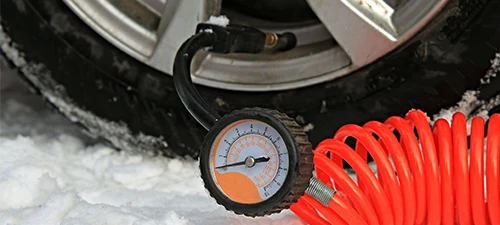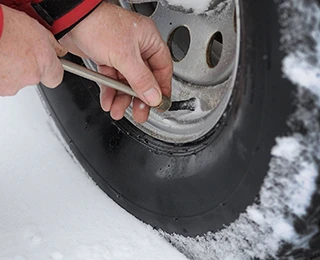What Should My Tire Pressure Be in Winter?
The wrong air pressure can cost you hundreds every year in lost fuel economy and premature tire wear. Air pressure that’s too low or too high can even cause issues with handling and safety. That’s why it’s so important to maintain the same, proper air pressure all year long, especially during the cold winter months when your tires can lose up to 1 PSI (pounds per square inch) for every 10 degrees the temperatures drop. Let’s review why proper air pressure is so important and how to check yours with tips from the pros at Les Schwab.
Why Tire Pressure Matters in Cold Weather
Maintaining proper air pressure in any weather can extend the life of your tires by promoting even tread wear. Proper air pressure can also improve your safety on the road and your fuel efficiency. This is especially true in cold, winter weather.
When temperatures drop so does the air pressure in your tires. That’s because the air molecules condense, leaving more room inside those tires. Here’s an example: blow up a balloon and add as much air as possible. Tie the end and place it in the refrigerator for an hour. In that time, the balloon will feel slightly deflated. But that same balloon will seem to reinflate once it reaches room temperature. The same thing happens with your tires when it gets cold outside.
Your tires could lose 1-2 PSI every month as air escapes the wheel and tire assembly. This is normal. In the winter, that loss ramps up to 1 PSI for every 10 degrees the temperatures drop. Losing upwards of 5 PSI can have a dramatic impact on your tires and safety, including:
Reduced MPG
Every mile per gallon counts, right? According to the U.S. Department of Energy, low tire pressure can decrease fuel efficiency by .2% for every 1 PSI.
Less Tire Life
Improper air pressure can damage your tires as well as decrease their lifespan. That’s because over and under-inflating can lead to uneven tire wear and possible failure.
Longer Stopping Distances
When you press on the brakes, you want to come to a stop as quickly as possible. Tires that aren’t adequately inflated won’t properly grip the road, which can lead to skidding and increased braking time.
Diminished Performance
Cornering, acceleration, braking, and comfort are all tied to the air pressure in your tires. Properly maintaining that pressure can help make your drive more enjoyable and safe.
Should You Overinflate Your Tires In Winter?
Just like underinflated tires can cause safety and performance issues, over-inflating your tires in winter can cause a loss in traction, compromised handling, a bumpier ride, premature tire wear, and reduced safety. There’s no good side to over-inflating your tires — ever!
This is especially true on snow-covered roads. The more a tire is inflated, the less effective the tread can be at providing traction. Keeping your tires properly inflated based on the manufacturer's recommended levels can save you money and improve your overall safety.
How Crucial Is The Inflation Pressure For Studded Winter Tires?
Similar to a set of all-season, all-weather, or performance tires, the air pressure in a set of studded winter tires should stay consistent with the manufacturer’s suggested levels. Over or under inflating studded winter tires won’t help you grip the road any better. And there’s a good chance you’ll quickly lose tire life and studs along the way.

How to Check Your Tire Pressure
Before you put air into your tires, check the air pressure. It’s easy to do. You’ll need an air-pressure gauge found at most auto parts stores. If you don’t have an air pressure gauge, or you just don’t have time, stop by Les Schwab and we’ll check your tire pressure for free. We’ll even air them to the proper level, if needed.
- Find your vehicle’s proper cold tire air pressure in your owner’s manual or on the driver’s-side door placard. Make a note of that number for your front and rear tires (those can sometimes be different numbers).
- Unscrew the valve stem cap on the tire.
- Press the air-pressure gauge to the stem. If you hear air escaping, re-apply the gauge. This will push the readout on the gauge.
- Note the air pressure reading.
- If the tire pressure is too high, release some air by pressing on the bit of metal inside the stem. If the pressure is too low, add a little air.
- Recheck the pressure.
- Put the valve stem cap back on when done.
Les Schwab Tip: If you notice any cracks, bulging, cuts, or chips in your tires, don’t add air. Instead, change to a spare tire and get to Les Schwab. Our pros will check them for safety and make recommendations.
Stay Safe This Winter
Your safety depends on your tires. Stop by Les Schwab and we’ll check the air in yours for free. We’ll even top them off if needed. Plus, our pros are ready to help you pick the right tires for whatever or wherever you drive, including winter conditions. Schedule your appointment or just stop by today.

